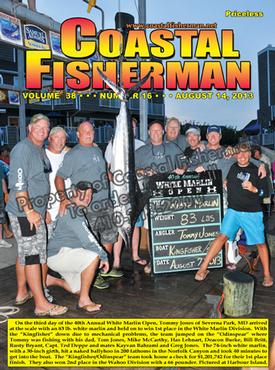


Article by Capt. Steve Katz
 Batteries
Batteries
Congratulations to this year’s White Marlin Open winners and good luck to all of the Mid-Atlantic $500,000 tournament participants.
The battery system is the cornerstone of the boat’s low voltage electrical system. While we have alternators, chargers, inverters, combiners, isolators, generators and solar panels, they all rely on the good batteries to function properly.
There are numerous components of the boat’s battery system and we will review a few of them below.
Let’s start with the most obvious, the battery. In a car or truck we do not give the battery much thought and it seems to last about 5 years until it stops working – usually at the worst possible time! In boats, the batteries usually last about three years and may give us trouble along the way. Why is this?
Battery types
The standard automotive battery is also called a cranking battery. It is designed to start an engine and be re-charged by the engines alternator. The starting battery is made up of lots of thin lead plates. It delivers a short burst of high amperage energy quickly, about 5% of its capacity to start an engine, and can do this task for thousands of starts. If this starting battery is run down to 20% to 50% of it’s capacity, the life of the battery is greatly reduced to possibly as few as 30-150 starts. This type of battery is good for the marine engine starting system but not for the electronics, pumps, lighting and other loads that can easily discharge a battery. If a starting battery has been completely discharged, it may not be able to be re-charged to its original capacity.
The deep cycle battery is constructed with fewer but thicker lead plates designed to deliver a long and low supply of power. This battery can be discharged to 50% of capacity without shortening the life of the battery. These batteries are great for "house" loads like trolling motors, pumps and electronics that can drain the battery by the end of the day. These deep cycle batteries are recommended for all marine systems.
Battery construction
Once the type of battery is selected for your application, there will be various battery construction choices available. The standard battery (least expensive) is the flooded lead acid battery. This can be the type with removable caps that allow you to add water, or the maintenance-free type that has sealed caps. They work the same way, though the sealed battery captures gases and vapor and re-deposits most of it back into the battery.
The next most popular is the AGM battery (Optima is the brand name that many consumers are familiar with by the distinctive red, yellow or blue top). An AGM battery can be twice the cost of a standard flooded battery but is superior for some applications. They truly are a maintenance-free battery. The electrolyte (battery acid) is absorbed in porous microfiber glass separators between the lead plates, decreasing internal resistance and increasing capacity. They are a great battery for hard to reach locations. These AGM batteries have a very low self discharge rate and can be recharged much faster than a traditional flooded battery. Gel batteries are similar to AGM, though the electrolyte is gelled by adding silica. These gel batteries are good for boating, but have special charging needs that may require significant modification to the boats charging system.
Charging
All batteries need to be re-charged back to full capacity to keep them in top condition and prolong their useful life. The on-board battery charger is an important part of the low voltage system; it usually runs for a longer period of time than the engine alternators and can affect the function and life of your batteries. Different batteries have different charging requirements and some battery chargers have adjustments to allow you to adjust the charge voltage for the type of battery. The AGM and flooded battery have similar charging parameters but the gel battery is notably different. All batteries are temperature sensitive in regards to the charging voltage and some battery charges have a temperature sensor to help adjust the charge based on temperature.
The engine alternator is also used to recharge the batteries when the engine is running. They deliver a lot of power and are capable of recharging a battery rather quickly. The size and voltage settings are selected by the engine manufacturer and are adequate to re-charge most battery systems except for Gel.
Older battery chargers use Ferroresonant technology and can only produce a constant voltage, similar to a heavy duty trickle charger. Newer chargers are “three stage” and use electronics to adjust between bulk, absorption and float, all different levels of charging voltage. These three-stage chargers are good at quickly recharging without overcharging the battery.
Battery Banks
In larger boats, batteries are often grouped together into “banks”, which are a group of batteries connected together to act as one. If a traditional 12 volt battery is connected in parallel, the amperage is combined and the voltage stays the same. If the batteries are connected in series, the voltage is combined to make 24 volts and the amperage is the same.
On smaller boats it is advantageous not to permanently connect batteries in parallel. This ensures the “house” loads do not discharge the engine starting battery. A better wiring method is to use an ACR – Automatic Charging Relay. This is like a smart battery switch that only connects the batteries in parallel when the engine alternator is charging and disconnects the parallel when the engine is not running or charging.
This information will help you purchase and maintain the correct battery for your boats needs.
Captain Steve Katz, ABYC Master Technician, is owner of Steve’s Marine Service serving Annapolis and Ocean City, MD.